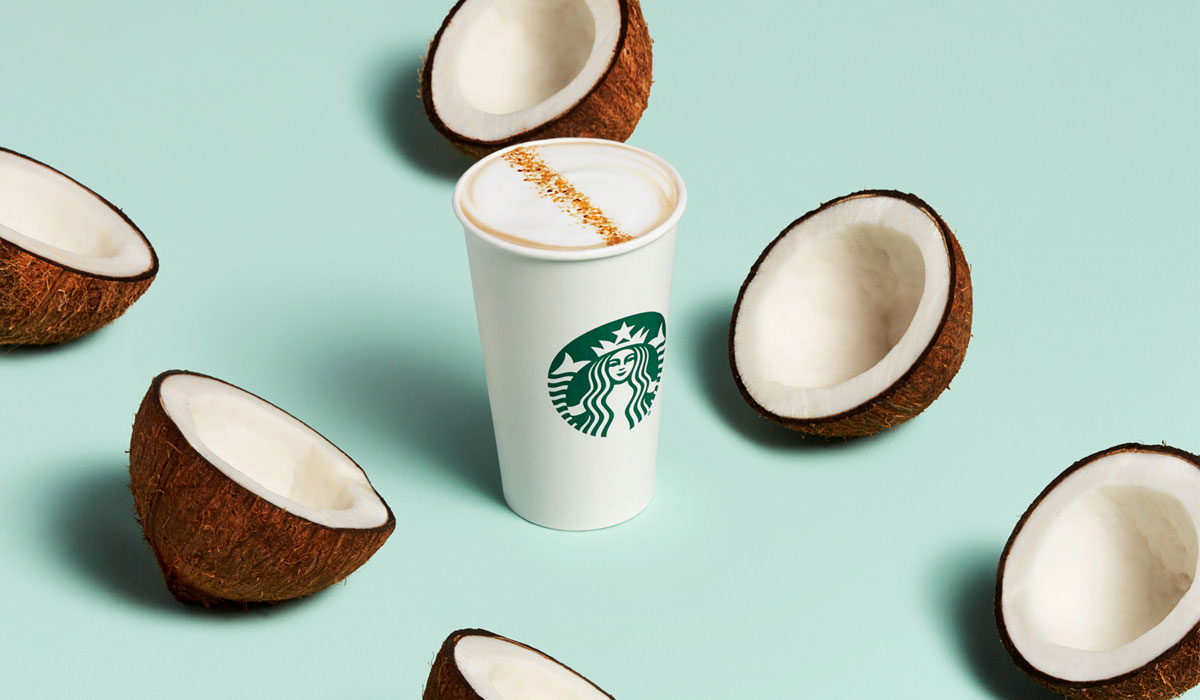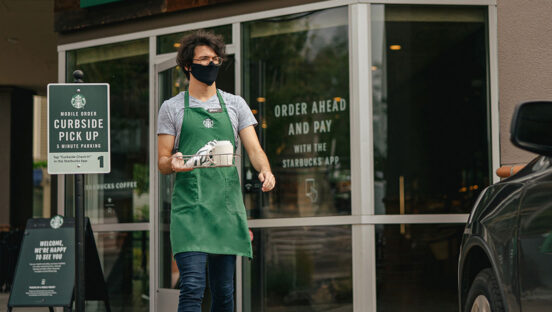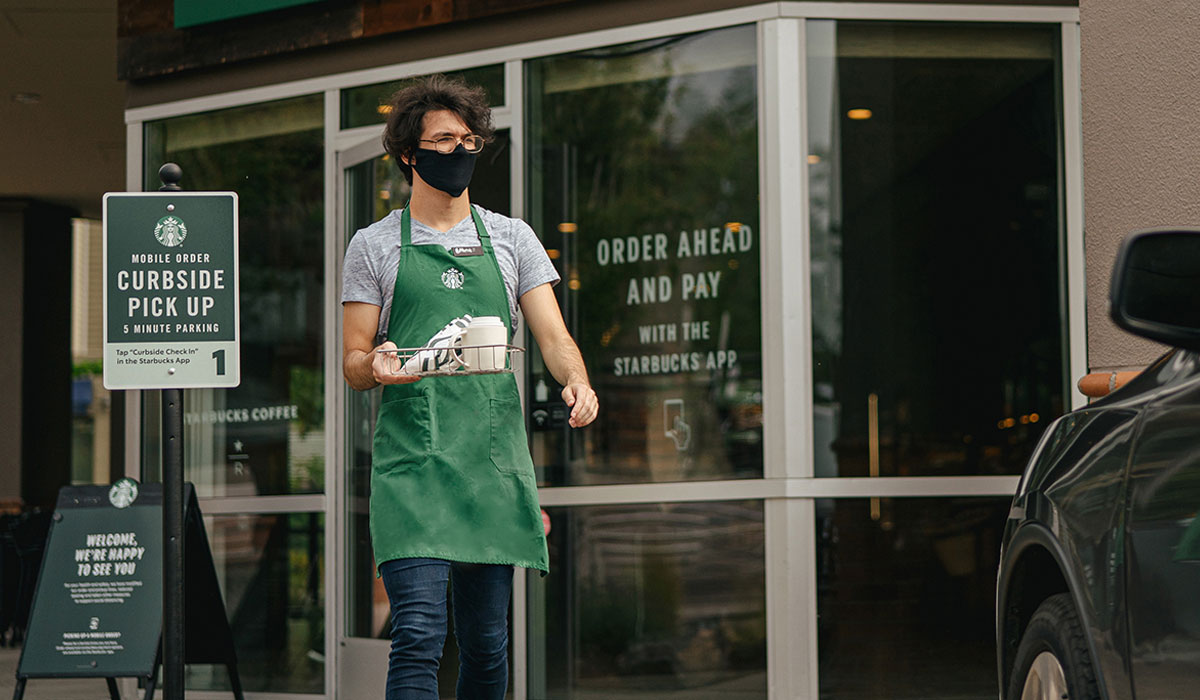Starbucks’ “third-place” DNA it built a coffee empire on isn’t vanishing. Yet here’s an example of how customer experience has veered under a COVID-19 umbrella. Starbucks’ outgoing chief operations officer Roz Brewer, set to leave and become Walgreens CEO at the end of February, teased earlier in the week the “final piece” of the company’s efforts to widen accessibility in preparation for a post-coronavirus world.
Brewer called it “the future drive-thru concept,” which appears similar to other models shared by the sector’s largest players in recent months, from McDonalds to Burger King to KFC. Yet more striking in Starbucks’ case given its history as a gathering concept as much as one that serves coffee. “And those are things like drive-thru only stores that have no seating, very small units, the side-by-side drive-thru lanes that we are bringing on to the footprint,” Brewer said during a conference call. “So we’ve got considerable work in this area to unlock the full potential for drive thru.”
The present reality for Starbucks, when you factor work-at-home and COVID’s demolition of day-to-day routines, is the company’s visit has evolved from the stop on the way to a destination to being the destination worth leaving home for, CEO Kevin Johnson said.
And so group orders are up (average ticket rose 19 percent in Q1), and so is demand for convenience—something Starbucks didn’t exactly skirt before, but surely wasn’t paragraph 1 of its mission statement.
In this shift, Starbucks spent the past 10-plus, pandemic-riddled months expanding digital reach, enabling curbside pickup, furthering delivery, and, most critically, increasing throughput in the drive thru.
U.S. stores with drive thrus reported a “slight” improvement in out-the-window times in Q1, Johnson said, and delivered positive same-store sales throughout the period. They drove more than half of the company’s net sales, increasing north of 10 percent from pre-COVID levels.
While Starbucks did not detail what “slight” entailed exactly, when you weigh lengthy lines and added volume, it’s likely a significant return. Taco Bell, for reference, once said it boosted drive-thru speed of service 18 seconds, year-over-year, and served an additional 4.8 million cars. Those things aren’t entirely reliant on one another, yet the correlation between faster service and being able to serve more guests is a straightforward notion.
“These results give us confidence that our targeted initiatives to unlock capacity and enhance the customer experience at our drive-thru locations are boosting our business recovery while strengthening our foundation for future growth,” Johnson said.
THE COVID ROAD FOR STARBUCKS SO FAR:
Starbucks Exec Roz Brewer to Leave Company, Become Walgreens CEO
Starbucks to Assist with Washington’s Vaccination Rollout
Starbucks Says it Will Have 55,000 Locations by 2030
Starbucks Plans Pay Raises for All Employees
Starbucks to Close 800 Stores as it Readies for the Future
Starbucks Isn’t Waiting Around for COVID to Disappear
Starbucks Turned Summer Into Fall, and it Paid Off
Starbucks to Take Page from Chick-fil-A’s Drive-Thru Playbook
COVID-19 Accelerates the Transformation of Starbucks
Starbucks Pushes Fowrard Plan to Relocate, Transform Low-Performing Stores
COVID-19 Has Cost Starbucks $915 Million So Far
Starbucks was Preparing for the Coronavirus in February
Speaking to future real estate, Brewer said Starbucks’ most productive model is now its drive thru. “So in our go-forward position, you’ll see an increased number of drive thrus that we’re building in the central United States and across the Southeast and Southwest,” she said.
There are three main approaches Starbucks is taking to enhance drive-thru productivity.
One is to optimize the current setup, which involves looking at operation standards. Or the speed of service conversation.
Second is the development and tests around drive-thru forward solutions. Namely, this concerns Starbucks’ handheld point-of-sale devices for employees to walk lines and take orders in advance. It’s something Chick-fil-A and In-N-Out carry the banner on. Brewer said Starbucks has the feature live in about 300 drive-thru stores today, and will tout 500 by the end of February.
The premise is Starbucks can start “busting the line,” a retail term that highlights the ability to take orders on mobile tablets faster than counter staff can operate a stationary terminal. Like the first effort from Starbucks, it centers on getting orders into the queue faster and improving those out-the-window times.
“And so, we’re also adding to that the tech improvement to make orders more easily managed through our consolidation in hand off, we call that our ‘bump-bar’ replacement,” Brewer said.
Starbucks previously noted it wanted to deploy technology within handhelds to give guests the option, if the line got too long, to walk into the café and pickup.
Additionally, Brewer said Starbucks is targeting the renovation of 150 drive-thru constrained stores that have either issues in terms of meeting the company’s new productivity model from a design standpoint, or other tangible, physical barriers.
And the last ticked box will be the drive thru of the future design, complete with no-seating models and multiple lanes.
Roughly 40 percent of Starbucks’ footprint doesn’t feature a drive thru today, leaving the company to focus on productivity within the four walls as well. This includes everything from a Sirena Espresso Machine that allows for faster pulls to new warming ovens and Starbucks’ “Deep Brew” program. The latter applies artificial intelligence to equipment and processes. For example, it helps automate inventory management and reduces the amount of time employees have to count inventory and fill out forms.
Starbucks’ Mastrena 2 machines have sensors that, for every shot of espresso, send telemetry data back to corporate so they can predict when maintenance, cleaning, or calibration is needed through machine learning. The goal being to prevent an employee showing up in the morning to discover a broken device. “So technology to automate administrative tasks that help provide the best environment for our partners to do what they do best, which is handcrafted beverages and connecting with our customers,” Johnson said, adding Starbucks’ 20,000-square-foot Tryer Center, which is based in Seattle, continues to work on ways to improve productivity with “human-centered design engineers.” Everything from store layout to equipment to AI is on the table.

A plant-based movement
Johnson was asked Tuesday where he thought consumer behavior was changing most going forward. His answer: Plant-based, which he called a “dominant shift” for Starbucks.
The brand has addressed this mainly through alternative milks, like oat and soy, and so forth. It’s been 15 years since the first Starbucks soy latte (and soy chai tea latte and soy cappuccino) was served. Starbucks launched its first dairy alternative in 1997 and added coconutmilk in 2015 and almondmilk in 2016. January 2020 marked the regional introduction of oatmilk.
On the food side, there are options like the Impossible Sausage Breakfast Sandwich. But notably, Johnson shared Starbucks actually has a restaurant in Seattle that features a 100 percent plant-based food menu.
In general, however, Starbucks has seen higher beverage and food attachment during COVID. There’s been a shift to cold drinks as well, which were gaining momentum pre-virus. If you think about the decline in transactions Starbucks has taken in central business districts and metro markets, Brewer said, those areas carry single beverages and mixed higher with brew coffee sales, which skew at a lower range in Starbucks’ ticket options.
“So what we’re doing in beverage innovation is replacing that with cold beverages and replacing that with plant-based,” she said. “And so that’s why we’re seeing this improved food attach and so we feel confident that those kinds of innovations are going to keep that ticket higher than what we’ve seen in the past.”
To date, plant-based beverages haven’t made much of an impact on Starbucks’ beverage margins. It’s a push since there’s incremental cost associated with alternative milks and yet the brand charges a premium. “I would say much longer-term, it remains to be seen,” said CFO Patrick Grismer, who is returning, effective February 1. “A lot of it will depend on how consumers increasingly migrate to those alternative milks, not just in our business, but broadly in a way that supports increased production, which should over time reduce the cost and then we have the opportunity to reevaluate whether at some stage it makes sense to change our pricing practices.
Recovery on track
Starbucks’ global same-store sales declined 5 percent in Q1—a number driven by a 19 percent decrease in traffic and partially offset by a 17 percent boost in average ticket.
Comps in the Americas fell 6 percent, with transactions down 21 percent and average ticket up 20 percent. U.S. same-store sales slid 5 percent as traffic decreased 21 percent and average ticket hiked 19 percent.
U.S. figures were down 4 percent and 8 percent in November and December, respectively, as pandemic-related operating restrictions picked up. About 40 percent of domestic corporate stores offered limited seating at the end of the period, down from more than 60 percent at the beginning. Same-store sales were negative 3 percent in October.
Starbucks’ Q1 result of negative 5 percent was better than Q4 2020’s negative 9 percent, even with the latter half disruption.
In the quarter, mobile orders represented 25 percent of U.S. company-operated transactions, up from 17 percent pre-COVID.
Grismer said, in line with prior calls, Starbucks expects to achieve full sales recovery in its U.S. business by the end of Q2, with a two-quarter lag before it believes it will see full margin recovery.
Starbucks projects same-store sales will decline 2 percent in January. Then, as it laps COVID impacts in March, it believes growth with track in the 5–10 percent range, year-over, for the second quarter.
The brand’s Rewards loyalty program 90-day active members in the U.S. also increased to 21.8 million, up 15 percent year-over-year, and a 2.5-million-member lift. It’s now surpassed Starbucks’ figures from before the pandemic. Rewards customers contributed 50 percent of corporate sales, up from 43 percent last year and 47 percent in the previous quarter.
Also, quarter-over-quarter, Starbucks’ mobile app downloads grew by 5 percent and our acquisitions 13 percent.
International comps dipped 3 percent on a 10 percent decline in transactions and 8 percent rise in average ticket. In China, they rose 5 percent (3 percent decline in transactions, 9 percent lift in average ticket).
Starbucks opened 278 net new stores in Q1 and exited the period with 32,938 stores, of which 51 and 49 percent were company-run and licensed, respectively. The U.S. had 15,340 locations. China 4,863.
Starbucks posted consolidated net revenues of $6.7 billion, a 5 percent decline versus the year-ago period.
Adjusted earnings per share were 61 cents, which beat Wall Street expectations of 55 cents.










